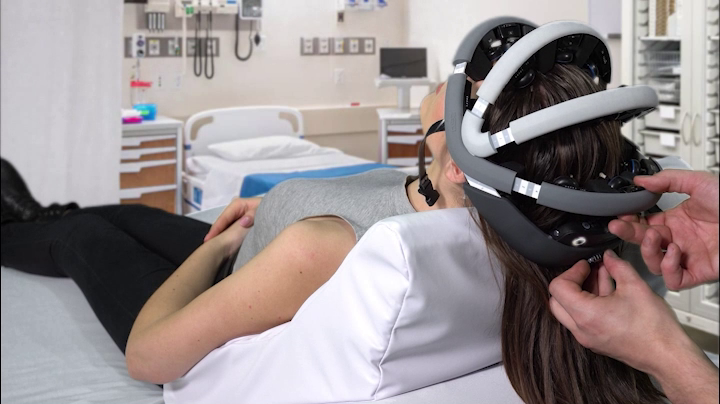Home » Case Studies » Virginia Thornley, M.D.
Case Study of
Virginia Thornley, M.D.
Ease of Use and Convenience Make the Zeto EEG Headset Perfect for Solo Neurologist Practices

Virginia Thornley, M.D.
Dr. Virginia Thornley is a Board-Certified Neurologist who owns a solo neurology practice in Sarasota, Florida. She completed her neurology residency at the University of Vermont where she served as Chief Resident. After finishing a 2-year Epilepsy and Neurophysiology Fellowship at the University of Rochester, Dr. Thornley practiced neurology for nearly a decade in NYC at St. Luke's Roosevelt Hospital and Harlem Hospital and in private practice.
When COVID was raging in July 2020, Dr. Thornley opened “Elite Neurology” in Sarasota, Florida, a one-neurologist practice. “Agree 100% small practices give more personalized care. Many people around us own businesses, why not us doctors? Doctors have the knowledge and the skill set. All doctors should consider solo practices”, she shared in her Twitter.
“It’s hard, it’s stressful, and it’s mine,”
she added about her solo neurology practice in September, 2020. In 2021, Dr. Thornley’s colleagues selected her as a Top Doctor in Neurology.
Problem
Dr. Thornley manages patients with a wide variety of complaints including migraine, dizziness, memory loss, head injury, and movement disorders. However, she has a particular interest in the diagnosis and treatment of epilepsy, her sub-specialty. The Zeto EEG is the core study in Dr. Thornley’s epilepsy practice, mainly consisting of routine 22-minute EEG’s, 72-hour ambulatory EEG’s, and long-term video EEG monitoring. However, getting an EEG program up and running in a solo practice proved to be a struggle. Dr. Thornley faced these challenges:
- EEG machines are a large capital expense for a solo practice
- Finding qualified and affordable EEG technicians who are available immediately for her growing practice
- COVID-19 made finding and retaining reliable medical staff doubly burdensome
- Without EEG technicians available, the choice is to either delay care and refer patients to get the EEG done elsewhere, or for the physician to step in
- Troubleshooting a traditional EEG machine is time that a solo neurologist cannot afford to waste
Because of these challenges, Dr. Thornley searched for a reliable EEG system that would allow her to acquire high-quality accurate EEG studies on her own.
Solution
“Zeto is a life-saver. As a micropractice starting out in the middle of the pandemic, it helped me tremendously,” states Dr. Thornley. “Not required to have specialized EEG technicians. I perform my own EEG studies. I can do other administrative work in between studies. It saves the need of having to coordinate schedules with a technician and saves on overhead, which were the selling points for me. I love how easy it is to use. Once you are familiar it is very easy to apply the headset with minimal artifacts.”
“It exactly suited what I was looking for weeks,” Dr. Thornley continued. “It’s the first time I got excited by a piece of medical equipment”.
Within hours of a product demonstration, Dr. Thornley was so impressed by the features and that the system can record up to 6 hours of EEG data, she purchased the Zeto EEG system in fall of 2020.
Incorporating the Zeto EEG into a Busy, Solo, Private Neurology Practice
According to Dr. Thornley, the learning curve to implement Zeto EEG is a bit steep, but once you become familiar with the set-up, it is very simple. “It is perfect for a private practice owner such as myself as I can easily throw it on in minutes which is far less time compared to the conventional electrodes using gel. Taking it off is an easy 1 minute. I quickly change settings with the touch of a button. It uses wi-fi and has a buffer if your internet goes down.”

Pros
- Once you become familiar with the set-up, it becomes second nature to use
- No messy electrodes
- If you have background in EEG, it’s easier to take on and off compared to older technology
- Biggest innovation in EEG since the mid-80s, when EEG switched from paper to digital
- Not required to have specialized EEG technicians, who are in extremely high demand since the start of COVID-19
- Its software is always up-to-date because it operates on a cloud platform and that also means there is very little IT knowledge or budget required
- It has a buffer, so the Zeto EEG keeps recording even if your internet goes down
Cons
- Learning curve is steep initially
- No customizable reporting templates yet but an advanced report writer is available for a minimal fee
For Dr. Thornley, the pros far outweigh the cons. “I’m my own technician. I work part-time and I do about 2 to 4 EEG studies a week, or about 12-15 studies a month. Technical assistance is easy when you have questions. It is easy to use and maneuver. I usually read the results immediately after I see patients and share the results in near real-time,” she states.
Tips and tricks from Dr. Thornley on using the Zeto EEG machine
- Make sure the headset is perfectly placed before starting. Adjust the device so all the prongs are straight and touching the scalp. Once setup is complete, the signal quality indicators will turn green. After that, adjust the electrodes that show up as red on the screen as needed.
- Tighten the headbands enough so it’s not too loose on the head or you may lose contact if the patient moves
- When in doubt or it’s not running, turn everything off, disconnect and reconnect
- Plug your laptop in, so you don’t start from scratch if you are low on battery
- Check in from time to time for artifacts. You don’t want to come in at the 22-minute mark to find everything dislodged and you have to start from scratch
- Taking off the Zeto EEG is easy; clean-up takes less than 5 minutes
- Take off the dry electrodes and discard them
- Clean the headset with alcohol swabs
- Disconnect the lead from the photic stimulator
- Disconnect the Zeto Interface Box (ZIB) which helps with spotty Wi-Fi
- Clean the references leads with alcohol swabs
Results
Dr. Thornley adds, “I am continually impressed by the ease of use and how well [Zeto EEG] fits into my practice. It works seamlessly with my schedule. Patients are impressed by the technology. I strongly recommend this to my colleagues in Neurology looking for excellent EEG equipment that is not only easy to use but easy to incorporate in a busy practice. I look forward to the future technological advances from this forward-thinking, immensely inventive company.”
Dr. V. Thornley’s website: https://virginiathornleymd.com/
She shared her experience with Zeto EEG on her Instagram:
Dr. Virginia Thornley also has her own blog: https://neurologybuzz.com
CPT Codes
You can bill the same CPT codes for EEG’s as you do with traditional EEG equipment.
Common Routine EEG Codes Utilized for Zeto EEG
| CPT Code | Description |
|---|---|
| 95812 | EEG extended monitoring; 41-60 minutes |
| 95813 | EEG extended monitoring; 61-119 minutes |
| 95816 | EEG including recording awake and drowsy; 20-40 minutes |
| 95819 | EEG including recording awake and asleep; 20-40 minutes |
| 95822 | EEG recording in coma or sleep only; 20-40 minutes |
Additional codes billable for Zeto are any that cover recordings up to 6 hours, including simultaneous video, for example, 95705, 95711, 95706, 95712, 95707, 95713, 95717, and 95718.
Zeto offers FDA-cleared hardware and software solutions to record clinical-grade EEG data with minimal setup needs, as detailed here.